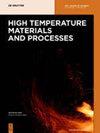Experimental study on the preparation of ferrophosphorus alloy using dephosphorization furnace slag by carbothermic reduction
IF 1.5
4区 材料科学
Q4 MATERIALS SCIENCE, MULTIDISCIPLINARY
引用次数: 0
Abstract
Abstract With the development of the duplex converter process, the amount of dephosphorization furnace slag is increasing, and it has relatively low basicity. It has been indicated that the recovery of valuable elements from dephosphorization slag by carbothermic reduction has great environmental and economic benefits due to its high content of P, Fe, and Mn. In this work, the experimental slag was reduced by carbon powder in a resistance furnace at 1,550°C. The results show that 76.82% of P, 99.60% of Fe, and 11.82% of Mn in the slag are recycled at basicity 1.0, and the recovery ratios of P, Fe, and Mn are 34.58, 78.89, and 13.85% at basicity 2.0, respectively. The ferrophosphorus obtained from the reduction of the dephosphorization furnace slag can be used as a raw material for steel-making alloy, and the residual steel slag can be used as cement and other building materials. This work provides a reference for recycling and resource utilization of dephosphorization furnace slag.碳热还原脱磷炉渣制备磷铁合金的试验研究
摘要随着双转炉工艺的发展,脱磷炉渣的用量不断增加,且其碱度相对较低。研究表明,碳热还原法回收脱磷渣中磷、铁、锰含量高,具有良好的环境效益和经济效益。在1550℃的电阻炉中,用碳粉还原实验渣。结果表明:碱度为1.0时,渣中P的回收率为76.82%,Fe的回收率为99.60%,Mn的回收率为11.82%;碱度为2.0时,P、Fe和Mn的回收率分别为34.58、78.89和13.85%。脱磷炉炉渣还原得到的磷铁可用作炼钢合金的原料,剩余的钢渣可用作水泥等建筑材料。为脱磷炉渣的回收利用和资源化利用提供参考。
本文章由计算机程序翻译,如有差异,请以英文原文为准。
求助全文
约1分钟内获得全文
求助全文
来源期刊

High Temperature Materials and Processes
工程技术-材料科学:综合
CiteScore
2.50
自引率
0.00%
发文量
42
审稿时长
3.9 months
期刊介绍:
High Temperature Materials and Processes offers an international publication forum for new ideas, insights and results related to high-temperature materials and processes in science and technology. The journal publishes original research papers and short communications addressing topics at the forefront of high-temperature materials research including processing of various materials at high temperatures. Occasionally, reviews of a specific topic are included. The journal also publishes special issues featuring ongoing research programs as well as symposia of high-temperature materials and processes, and other related research activities.
Emphasis is placed on the multi-disciplinary nature of high-temperature materials and processes for various materials in a variety of states. Such a nature of the journal will help readers who wish to become acquainted with related subjects by obtaining information of various aspects of high-temperature materials research. The increasing spread of information on these subjects will also help to shed light on relevant topics of high-temperature materials and processes outside of readers’ own core specialties.
 求助内容:
求助内容: 应助结果提醒方式:
应助结果提醒方式:


